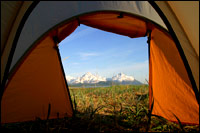Hi Umbra,
When I posted this question locally, I started a brouhaha about owning a car. Hopefully you can answer more succinctly — any suggestions for a tent made out of reasonably friendly materials?
Alex Bernardin
San Francisco, Calif.
Dearest Alex,
There’s plenty to say about friendly tents, and nary a brouhaha in sight. Since I’m not sure from your question what you want the tent to be friendly to, or exactly what you want to use it for, let’s take a broad look at some of the options.

A beautiful day in the neighborhood.
Photo: iStockphoto
In terms of the environmental impact of materials, remember my previous column on the natural vs. synthetics debate. If you don’t recall, it basically turned out to be a wash — both have their pros and cons. So the best material for you will be a combination of personal preference and what you intend to use the tent for: semi-permanent shelter, car camping, or some rugged foray that requires the lightest model you can find.
If you’re looking for a semi-permanent shelter, options range from easy-to-find cotton tipis to slightly harder-to-find wool yurts to hard-to-find, relatively expensive hemp. Common materials offered by tipi and yurt companies also include a range of synthetics meant to withstand continued outdoor use, but if you’re chemically sensitive, or just don’t like the idea of living in PVC, go with one of the natural options. They should work well in relatively dry climates. They work less well and wear out sooner in chronically wet places, such as my back yard.
If you don’t need to live in your tent and don’t plan to carry it very far or very often, Army surplus stores tend to have a reasonably good selection of cotton-walled models. They’re relatively heavy (about 10 pounds for a two-person tent), but can be cheap ($40-$60). You might also contact an outdoor-gear company or a friend with sewing skills and see if they’ll make a custom tent in a fabric of your choice. Another option for DIYers is to do just that: patterns abound online. Since I haven’t tried them, I won’t endorse one. But that’s no reason not to give it a shot if you have time on your hands.
Finally, if you’re looking for lightweight, compact models in a natural fiber: well, you’re outta luck. In this category, though, a used tent is an excellent choice. (Actually, it’s an excellent choice no matter what your needs are, assuming you find one that’s still in good shape.) An older tent would be both relatively eco-friendly, since we like reusing, and not so bad for your health, as it will have lost that toxic new-tent smell. It should be relatively easy to find one at used-sporting goods stores, on eBay, in the classifieds, or from friends or family looking to upgrade their own equipment.
Whatever option you choose, just remember: leave no trace. And watch out for wild brouhahas.
Thermarestly,
Umbra


